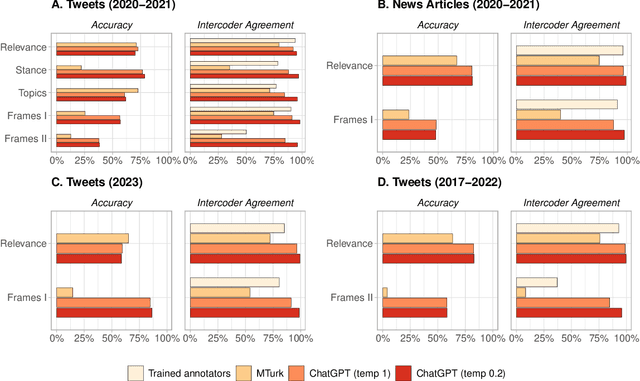Fabrizio Gilardi
Disclosure of AI-Generated News Increases Engagement but Does Not Reduce Aversion, Despite Positive Quality Ratings
Sep 05, 2024Abstract:The advancement of artificial intelligence (AI) has led to its application in many areas, including journalism. One key issue is the public's perception of AI-generated content. This preregistered study investigates (i) the perceived quality of AI-assisted and AI-generated versus human-generated news articles, (ii) whether disclosure of AI's involvement in generating these news articles influences engagement with them, and (iii) whether such awareness affects the willingness to read AI-generated articles in the future. We employed a between-subjects survey experiment with 599 participants from the German-speaking part of Switzerland, who evaluated the credibility, readability, and expertise of news articles. These articles were either written by journalists (control group), rewritten by AI (AI-assisted group), or entirely generated by AI (AI-generated group). Our results indicate that all news articles, regardless of whether they were written by journalists or AI, were perceived to be of equal quality. When participants in the treatment groups were subsequently made aware of AI's involvement in generating the articles, they expressed a higher willingness to engage with (i.e., continue reading) the articles than participants in the control group. However, they were not more willing to read AI-generated news in the future. These results suggest that aversion to AI usage in news media is not primarily rooted in a perceived lack of quality, and that by disclosing using AI, journalists could attract more immediate engagement with their content, at least in the short term.
Open-Source Large Language Models Outperform Crowd Workers and Approach ChatGPT in Text-Annotation Tasks
Jul 05, 2023Abstract:This study examines the performance of open-source Large Language Models (LLMs) in text annotation tasks and compares it with proprietary models like ChatGPT and human-based services such as MTurk. While prior research demonstrated the high performance of ChatGPT across numerous NLP tasks, open-source LLMs like HugginChat and FLAN are gaining attention for their cost-effectiveness, transparency, reproducibility, and superior data protection. We assess these models using both zero-shot and few-shot approaches and different temperature parameters across a range of text annotation tasks. Our findings show that while ChatGPT achieves the best performance in most tasks, open-source LLMs not only outperform MTurk but also demonstrate competitive potential against ChatGPT in specific tasks.
ChatGPT Outperforms Crowd-Workers for Text-Annotation Tasks
Mar 27, 2023
Abstract:Many NLP applications require manual data annotations for a variety of tasks, notably to train classifiers or evaluate the performance of unsupervised models. Depending on the size and degree of complexity, the tasks may be conducted by crowd-workers on platforms such as MTurk as well as trained annotators, such as research assistants. Using a sample of 2,382 tweets, we demonstrate that ChatGPT outperforms crowd-workers for several annotation tasks, including relevance, stance, topics, and frames detection. Specifically, the zero-shot accuracy of ChatGPT exceeds that of crowd-workers for four out of five tasks, while ChatGPT's intercoder agreement exceeds that of both crowd-workers and trained annotators for all tasks. Moreover, the per-annotation cost of ChatGPT is less than $0.003 -- about twenty times cheaper than MTurk. These results show the potential of large language models to drastically increase the efficiency of text classification.
Human-in-the-Loop Hate Speech Classification in a Multilingual Context
Dec 05, 2022



Abstract:The shift of public debate to the digital sphere has been accompanied by a rise in online hate speech. While many promising approaches for hate speech classification have been proposed, studies often focus only on a single language, usually English, and do not address three key concerns: post-deployment performance, classifier maintenance and infrastructural limitations. In this paper, we introduce a new human-in-the-loop BERT-based hate speech classification pipeline and trace its development from initial data collection and annotation all the way to post-deployment. Our classifier, trained using data from our original corpus of over 422k examples, is specifically developed for the inherently multilingual setting of Switzerland and outperforms with its F1 score of 80.5 the currently best-performing BERT-based multilingual classifier by 5.8 F1 points in German and 3.6 F1 points in French. Our systematic evaluations over a 12-month period further highlight the vital importance of continuous, human-in-the-loop classifier maintenance to ensure robust hate speech classification post-deployment.
 Add to Chrome
Add to Chrome Add to Firefox
Add to Firefox Add to Edge
Add to Edge